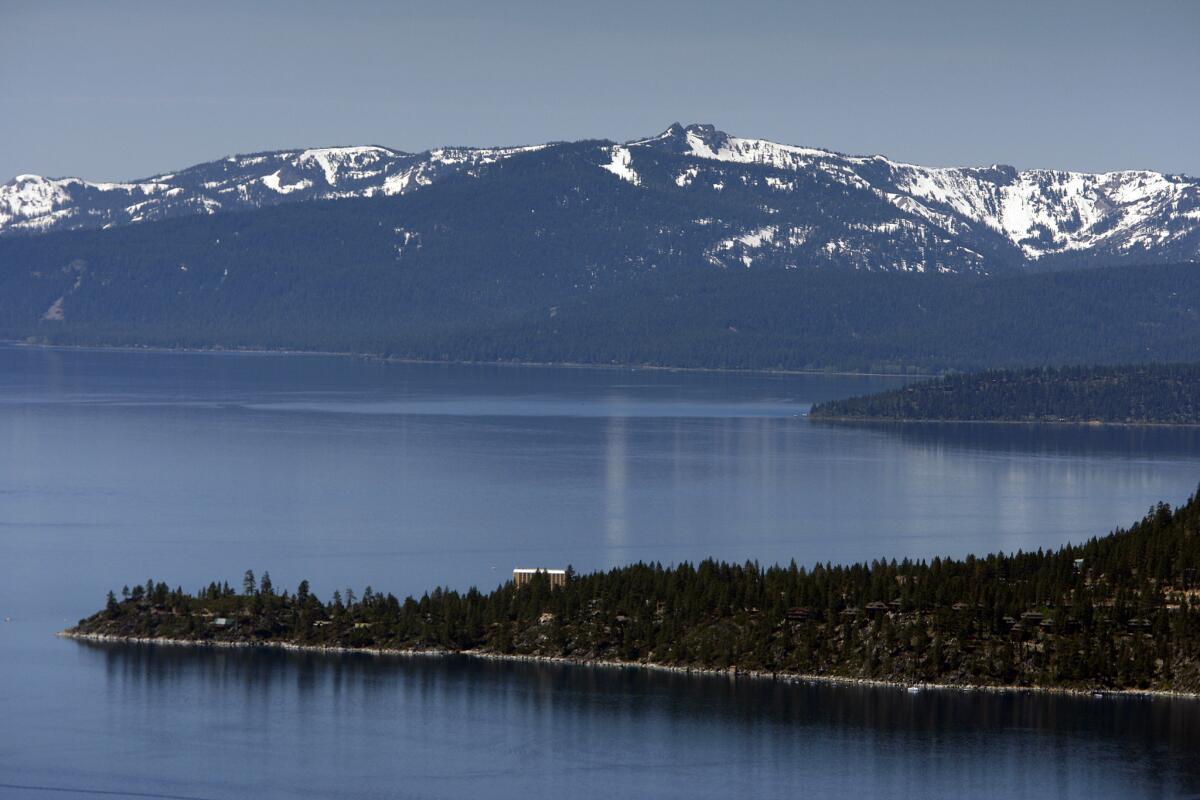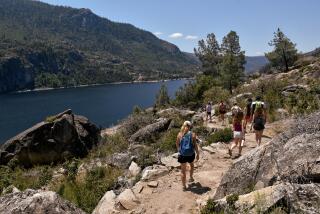Microplastics are found in Lake Tahoe’s waters for first time ever

- Share via
LAKE TAHOE, Calif. — Scientists have detected microplastic pollution in Lake Tahoe’s deep blue waters for the first time. Now they are trying to determine its source and potential harm to the lake’s flora and fauna.
Preliminary analyses of water samples collected by researchers at the Desert Research Institute in Reno revealed the presence of particles of synthetic fiber and bits of red and blue plastic no bigger than the head of a pin.
“On one level, we’re heartbroken and disappointed by this discovery,” said Monica Arienzo, an assistant research professor at the institute and leader of the investigation. “We really hoped we wouldn’t find much of this material in Tahoe’s water, which is almost entirely snowmelt.”
At the same time, she said, the team is looking forward “to diving deep into the many questions and concerns it raises.”
Tracing the particles to their source won’t be easy. Recent studies have shown that particles from discarded plastic products — flip-flops, toys, toothbrushes, water bottles, synthetic clothing, Styrofoam packaging and myriad others — can be transported long distances through the atmosphere by wind, rain and falling snow.
As a result, the pollution in the basin cradling Tahoe’s water could be local, or from locations around the world.
“Right now, we’re not sure where it came from,” Arienzo said. “But we’re definitely going to try and figure it out.”
The finding complicates a long struggle against erosion, sewage effluent, unbridled development, invasive clams and algae to save the lake, 6,225 feet in elevation. Federal state and local governments have spent more than $2 billion over the last six decades buying land and developing erosion control and wetlands restoration projects.
The shoreline of the lake, 22 miles long and 12 miles wide, has become one of the most tightly regulated places in the United States.
Yet, it didn’t take long for the researchers, part of the Nevada System of Higher Education, to find what they were looking for.
They used a system of pumps, funnels, tubing and filters to collect water samples 20 feet from the water’s edge at six locations, including areas of both high and low human activity.
The sampling was conducted throughout the spring at Tahoe Keys, a popular boating resort; Emerald Bay State Park, where boat access is limited; and at three stormwater outfalls into Lake Tahoe. The work was done in collaboration with the nonprofit League to Save Lake Tahoe’s citizen science program.
The team also collected water samples at other Nevada waterways including Lake Mead and the Las Vegas Wash.
To isolate particles caught in the filters, researchers oxidized organic matter such as insects, twigs and algae. Next, a high-density liquid-separation method was used to allow sediments to settle to the bottom and plastics to float to the top.
The team has since been examining the particles they collected under powerful microscopes for classification by size, shape, color, GPS coordinates and chemical composition.
Scientists who sampled seemingly pristine Arctic snow have discovered high levels of microplastics that were likely carried north by the atmosphere.
Microplastic debris is an emerging concern among scientists and environmentalists. Researchers recently found surprisingly high levels of microplastics in Arctic snow, demonstrating the global reach of these tiny particles of pollution.
About 245 million tons of plastic are produced annually around the world, according to industry estimates. That represents 70 pounds of plastic annually for each of the 7.1 billion people on the planet, scientists say.
Microplastics, potentially toxic and not biodegradable, have become a ubiquitous contaminant in the Pacific Ocean and seas around the world, scientists say. Much of it comes from densely populated coastal watersheds such as Southern California.
By contrast, the study of microplastics in freshwater alpine lakes such as Lake Tahoe is still in its infancy.
“Turning up this stuff at a world-famous nearly pristine mountain lake may move people to take action,” said Zack Bradford, senior science analyst at the League to Save Tahoe. “We’ll see.”
The Desert Research Institute team is scheduled to present its findings to the American Geophysical Union in December.
More to Read
Sign up for Essential California
The most important California stories and recommendations in your inbox every morning.
You may occasionally receive promotional content from the Los Angeles Times.











